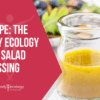Acne and Digestive Problems: The Skin-Gut Connection
The skin and gut connection has been recognized as undeniable in the medical community. In fact, most dermatologists will acknowledge that gut issues and skin problems frequently occur together.
The Relationship Between Acne and Digestion
Want to get rid of acne for good? It’s important to start incorporating fermented foods into the diet slowly so the gut has the proper time to heal and cleanse — by drinking a few ounces of InnergyBiotic a day.
One study investigated 13,000 adolescents. Those with acne were more likely to experience symptoms of gastrointestinal distress like constipation and heartburn. The study found that abdominal bloating, which is a sure sign of intestinal dysbiosis and inflammation, was 37% more likely to be associated with acne. (1)
Other studies have found a definite link between mental health and skin disorders. (2)(3) Some studies have even shown that stress can impair normal and healthy gut bacteria. (4)
In fact, as far back as 1930 physicians have had evidence to show that:
- Beneficial bacteria can improve inflammatory skin conditions.
- Beneficial bacteria can positively affect psychological symptoms, like depression.
- The health of the gut, brain, and skin are all interrelated. (5)
Beneficial bacteria like Lactobacillus acidophilus, which are found in fermented foods, can help heal intestinal permeability. (6)
Fermented foods naturally heal the gut mucosa and nurture a healthy inner ecosystem. The research suggests that probiotic-rich foods are an essential component in maintaining clear, healthy skin, as well as a clear, healthy mind. Nonetheless, when the gastrointestinal tract and immune system are damaged, even fermented foods can be overdone before the gut has time to heal.
Heal Your Acne: Take It Step by Step
Overdoing fermented foods before the gut has had time to begin healing and cleansing can aggravate certain conditions, like acne and migraines. That is why Body Ecology teaches the important Step by Step Principle.
Many fermented foods contain tyramine, arginine, and histamine. These are all molecules that affect vasculature. In fact, while too much tyramine in the diet can increase blood pressure, it has been found that arginine actually reduces blood pressure. Histamine, the molecule involved in an allergic response, also promotes blood flow. Tyrosine, arginine, and histamine have been found to aggravate chronic migraines. (7)
Common foods that contain large amounts of tyramine are:
- Smoked, aged, or pickled meat
- Most cheeses, especially Stilton
- Yogurt and sour cream
- Soy sauce
- Tofu
- Sauerkraut
- Peanuts
- Brazil nuts
Common foods that contain large amounts of arginine are:
- Diary foods
- Wheat germ
- Peanuts
- Nuts
Common foods that contain histamine are:
- Fermented foods and beverages, especially sake and wine
When starting fermented foods, listen to your body. Making your own fermented vegetables is easy. Or start with a few ounces a day of InnergyBiotic. If hormone issues are present, it is worth looking into Body Ecology’s Dong Quai probiotic liquid. Dong Quai is known as the “female ginseng” in Chinese Medicine. Just remember, take it Step by Step and slowly rebuild your digestive strength.
What to Remember Most About This Article:
- Physicians will sometimes recommend that their migraine patients go on a diet that is low in tyramine, arginine, and histamine. This has been found to also improve acne.
- The molecules tyramine, arginine, and histamine can be found in fermented foods. This may seem counterintuitive since decades of research have confirmed a solid relationship between the health of the gut and the health of the skin.
- While most people find relief from chronic health concerns with a diet filled with fermented foods, it is important to start slowly if your gut is compromised. Follow the Principle of Step by Step.
Product Recommendations:
- [product id=”169″]
- [product id=”75″]
- [product id=”3″]
- [product id=”1″]
REFERENCES:
- H Zhang, et al. Risk factors for sebaceous gland diseases and their relationship to gastrointestinal dysfunction in Han adolescents. J Dermatol. 2008; 35: 555 – 561.
- E Uhlenhake, et al. Acne vulgaris and depression: a retrospective examination. J Cosmet Dermatol. 2010; 9: 59 – 63.
- T Loney, et al. Not just ‘skin deep’: psychosocial effects of dermatological-related social anxiety in a sample of acne patients. J Health Psychol. 2008; 13: 47 – 54.
- SR Knowles, et al. Investigating the role of perceived stress on bacterial flora activity and salivary cortisol secretion: a possible mechanism underlying susceptibility to illness. Biol Psychol. 2008; 77: 132 – 137.
- Stokes JH, Pillsbury DH. The effect on the skin of emotional and nervous states: theoretical and practical consideration of a gastrointestinal mechanism. Arch Dermatol Syphilol. 1930; 22: 962 – 993.
- EC Lauritano, et al. Small intestinal bacterial overgrowth and intestinal permeability. Scand J Gastroenterol. 2010; 45: 1131 – 1132.
- Millichap, J. Gordon (Summer 2002). Noha News XXVII: 3–6. http://www.nutrition4health.org/nohanews/NNS02DietMigraineHeadaches.htm









